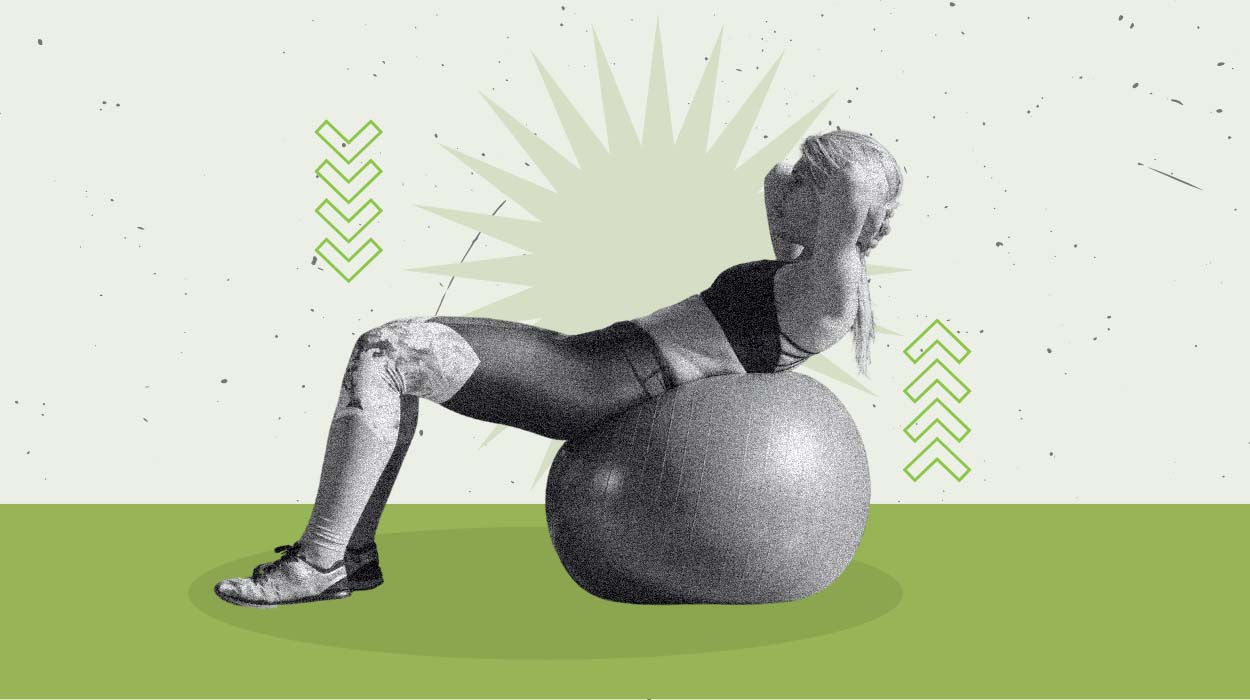
Are you bored with crunches and sit-ups? If you’ve reached a plateau and need a new challenge for stronger abs or even weight loss, try the ab workout with ball routines. This, combined with proper nutrients and supplements, might do the trick.
Stability or exercise balls, or even an ab workout with weight balls, allow you to work out your core and take on muscle-building in new and effective ways. Use a stability ball in the home or gym to stabilize your spine, maintain balance, and improve coordination skills. These ab exercises on balls are also effective in addition to fat burners if you want to lose weight.
Effective Ab Exercises With The Ball For A Strong Core
Here are eight effective ab exercises using a stability ball:
Best Ab Workout With Ball
Stability Ball Tuck
Stability ball exercises are fun and effective at the same time. You strengthen your chest, upper arms, legs, and knees with this one exercise.
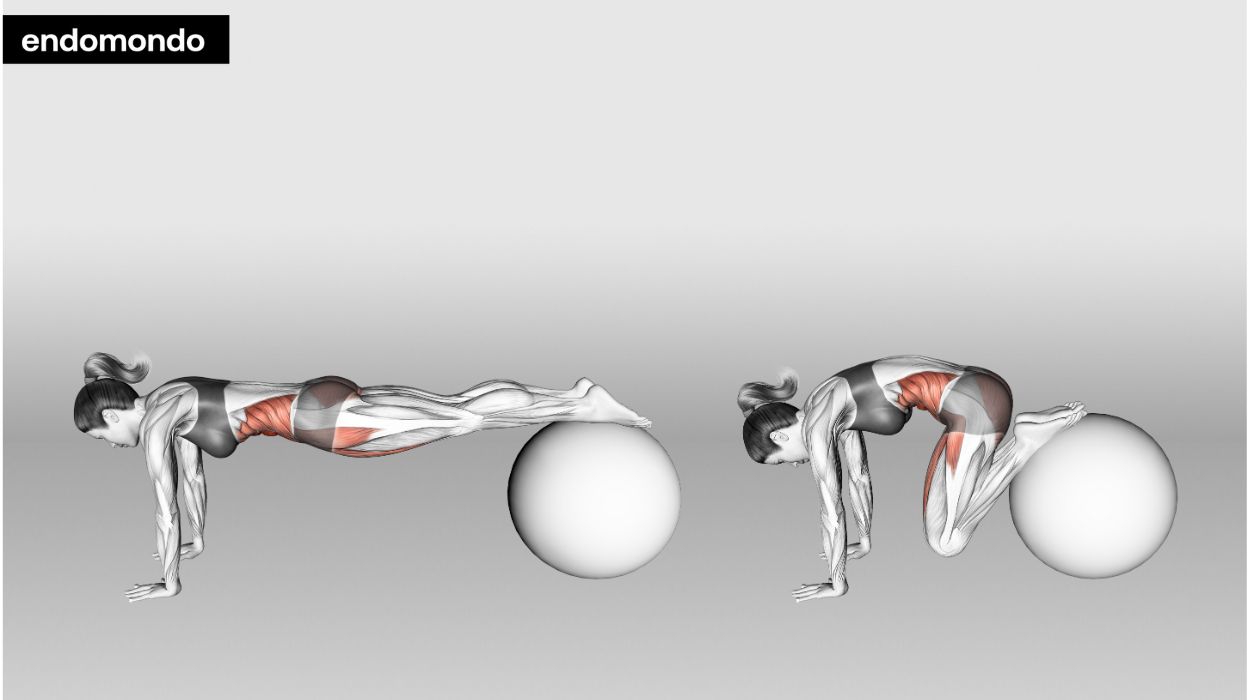
How to do:
- Begin in a high plank position by keeping your arms straight with your palms flat under your shoulder blades.
- Engage your core, and rest the top of your feet on the ball with your legs extended straight and your body forming a straight line in the starting plank position.
- Keep your hips level as you bend your knees and tuck them in toward your chest. The ball should roll toward you.
- Pause here for a moment before slowly extending your legs back out and returning to the starting position.
Tips:
- Keep your body in a straight line from head to heels to engage your core effectively.
- Inhale as you prepare to tuck your knees towards your chest, and exhale as you perform the tuck. Maintaining a steady breathing rhythm helps stabilize your core during the exercise.
- Don’t rush through the movement or let your hips sag. Focus on controlled tucks and keeping the ball stable to maximize the effectiveness of the exercise while minimizing the risk of injury.
Optimal Sets and Reps: 3 sets of 10-15 reps.
Stability Ball Crunch
This is a popular variation of abdominal crunches. The ball allows you to increase your range of motion, and you stretch and contract your rectus abdominus each time. For lower reps, go at a slower tempo focusing on harder contractions.
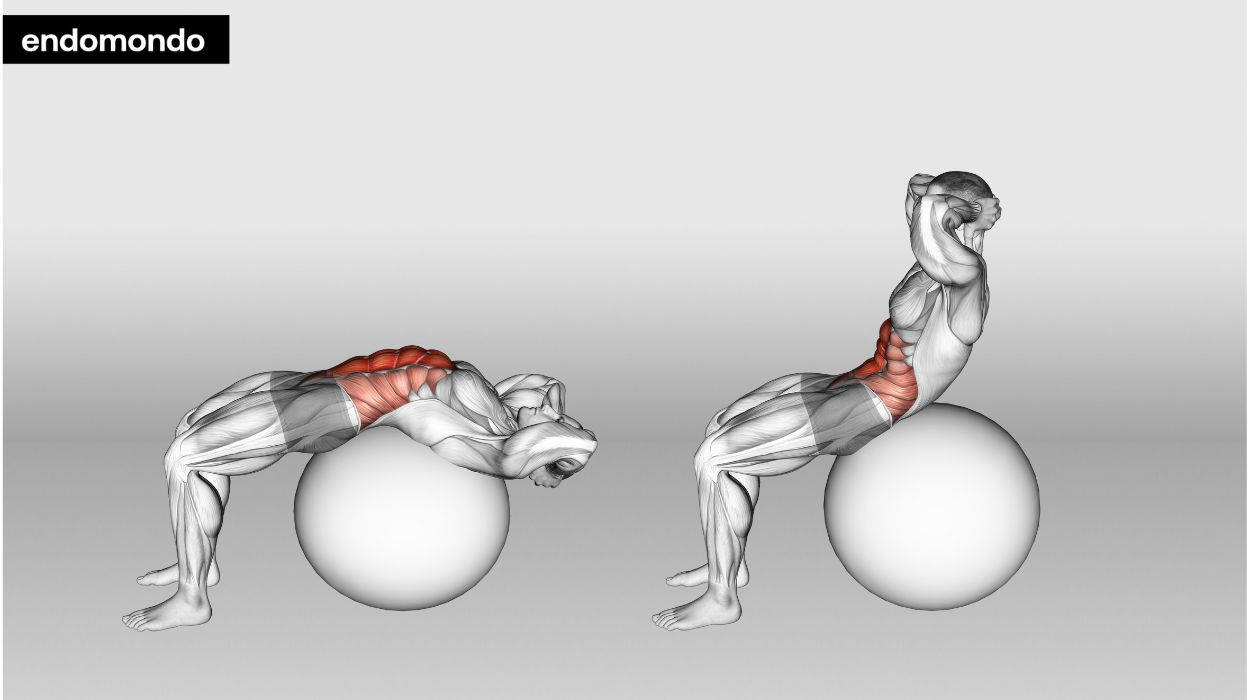
How to do:
- Lie faceup on the ball, and keep the ball centered under your lower back.
- Your feet should be flat on the floor, hip-width apart. Place your hands behind your ears.
- Brace your core as you lift your chin up toward the ceiling.
- Pause at the top of the movement before slowly returning to the starting position.
Tips:
- Start by sitting on the stability ball with your feet flat on the floor, and your lower back supported. Cross your arms over your chest or place your hands behind your head, but avoid pulling on your neck. As you crunch, engage your core muscles and lift your upper body towards your thighs, then lower back down with control.
- Exhale as you lift your upper body off the ball, contracting your abdominal muscles. Inhale as you lower yourself back down to the starting position. This synchronized breathing helps enhance core engagement.
- Avoid pulling on your head or neck with your hands, as this can strain your neck muscles. Focus on using your core strength to perform the crunch, and keep the movement controlled and deliberate to prevent excessive strain.
Optimal Sets and Reps: 3 sets of 12-15 reps.
Medicine Ball Forearm Plank Jack
This core exercise makes you pull the rectus abdominis muscle in, engage your glutes, and work your lower body.
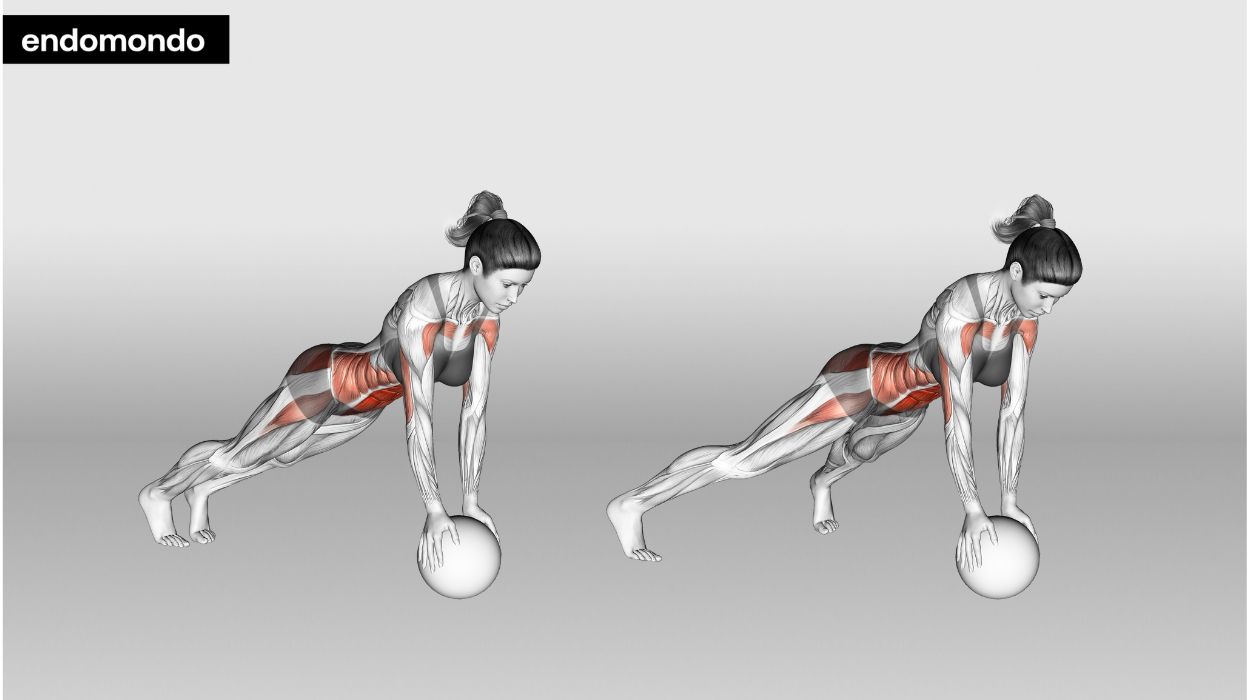
How to do:
- Place your forearms evenly on the medicine ball with your legs extended straight so your weight is resting on the balls of your feet. Your entire body should form a straight line.
- With your core engaged, jump your feet out wide like you would during a jumping jack.
- Quickly jump them back together and repeat the process.
Tips:
- Start in a forearm plank position on the ball, keeping your body in a straight line from head to heels. Engage your core muscles to prevent sagging or lifting of your hips.
- Inhale as you jump your feet out, and exhale as you jump them back in. Focus on controlled, rhythmic breathing throughout the exercise.
- Keep your wrists aligned with your elbows, and avoid excessive bouncing or jerky movements. Maintain stability to get the most out of this challenging core exercise.
Optimal Sets and Reps: 3 sets of 10-12 reps.
Stability Ball Hip Thrust
While this simple and effective exercise primarily works the glutes and hamstrings, it is also great for stabilizing the core. Proper form is essential, and unlike the bench version, this thrust is best performed with body bands as resistance to stay safe. You can use this exercise as a warm-up for lower-body training as well.
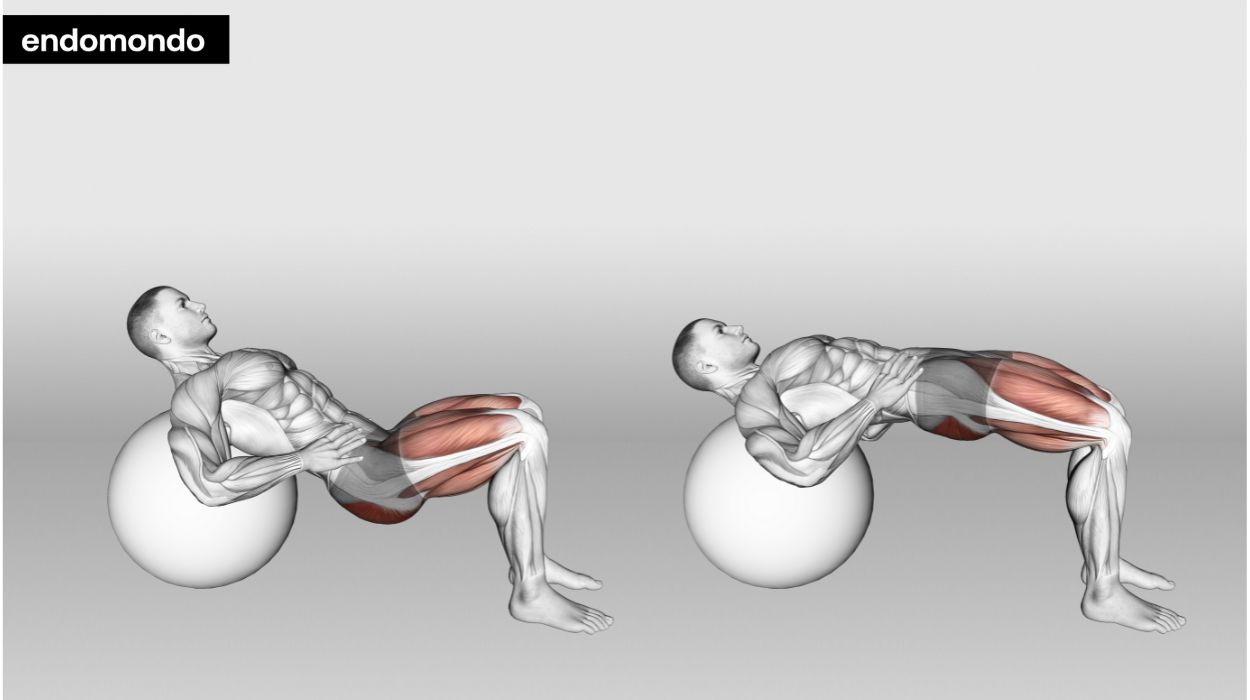
How to do:
- Start by sitting on the floor with your knees bent and your feet flat on the ground. Place a stability ball behind your back and lean against it.
- Roll the stability ball down your back until it’s positioned at your mid-back. Your upper back and shoulders should be resting on the ball.
- Engage your core and glutes, and press your hips upward toward the ceiling. Keep your feet firmly planted on the ground.
- Lift your hips until your body forms a straight line from your shoulders to your knees. Squeeze your glutes at the top of the movement.
- Hold the position for a moment to feel the contraction in your glutes and lower back.
- Lower your hips back down to the starting position.
- Repeat for a desired number of repetitions.
Tips:
- Ensure your upper back is supported on the stability ball, feet flat on the ground, and knees bent at a 90-degree angle. Keep your core engaged and avoid arching your back.
- Inhale as you lower your hips towards the floor and exhale as you push them back up. Maintaining a steady breathing pattern helps stabilize your core.
- Avoid overextending your lower back or letting your hips sag too low. Aim for a controlled movement, squeezing your glutes at the top of the exercise for maximum effectiveness.
Optimal Sets and Reps: 3 sets of 12-15 reps.
Stability Ball Oblique Crunch
All ab workouts on balls must begin with good posture to avoid injury. Brace your spine by using your pelvic floor muscles to draw your belly button inward while engaging your core muscles. As always, stop immediately if you experience pain.
How to do:
- Lie flat on your back on the stability ball with your feet planted flat on the floor. Pull your belly button toward your spine using your pelvic floor muscles, and tighten your glutes.
- Supporting your neck with your hands, crunch up slowly to the right. Lift your shoulder blades off the ball as you rotate yourself to the right.
- Lower yourself back down to the starting position.
- Switch sides and repeat on the left side.
Tips:
- Keep your feet flat on the ground, knees bent at a 90-degree angle, and your core engaged. This ensures you target the oblique muscles effectively.
- Exhale as you lift your torso and shoulder blades off the stability ball to engage your obliques fully. Inhale as you return to the starting position.
- Place your hands lightly behind your ears to support your head, but don’t pull on your neck. Focus on using your obliques to lift, not your neck muscles.
Optimal Sets and Reps: 3 sets of 12-15 reps on each side.
Stability Ball Wide Side Crunch
This single-joint, stability ball wall exercise emphasizes your obliques while improving core stability and balance.
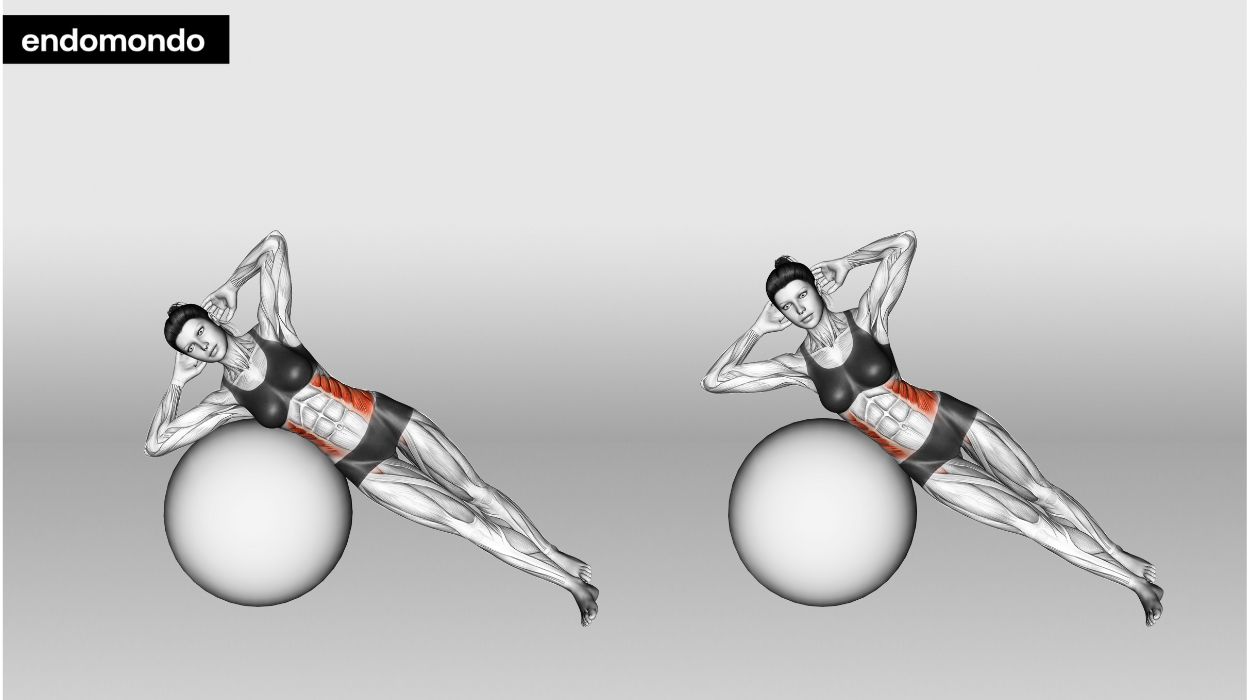
How to do:
- Lay your right hip on top of the stability ball. Have your right knee bent and your foot flat on the ground for support. Your left leg will be fully extended out with your weight on your toes to help you stay balanced.
- Keeping your hands placed behind your head, Slowly lean to the right side, keeping your core engaged and your back straight, and crunch up so you feel a contraction on your left side.
- Slowly lower yourself back to the starting position before repeating.
- Perform for a desired number on each side, then switch sides.
Tips:
- Ensure your stability ball is firmly positioned under your hip and lower ribs. This provides stability and maximizes the effectiveness of the exercise.
- Exhale as you lift your torso engage your obliques, and inhale as you return to the starting position. Proper breathing helps enhance the contraction of your abdominal muscles.
- Place your hands lightly behind your ears to support your head, but avoid pulling on your neck. Focus on using your oblique muscles to lift, not your neck muscles.
Optimal Sets and Reps: 3 sets of 12-15 reps on each side.
Stability Ball Feet Hand Pass-Off
Passing the stability ball back and forth causes you to stabilize and flex your abdominal muscles. Your legs also get a great hamstring stretch.
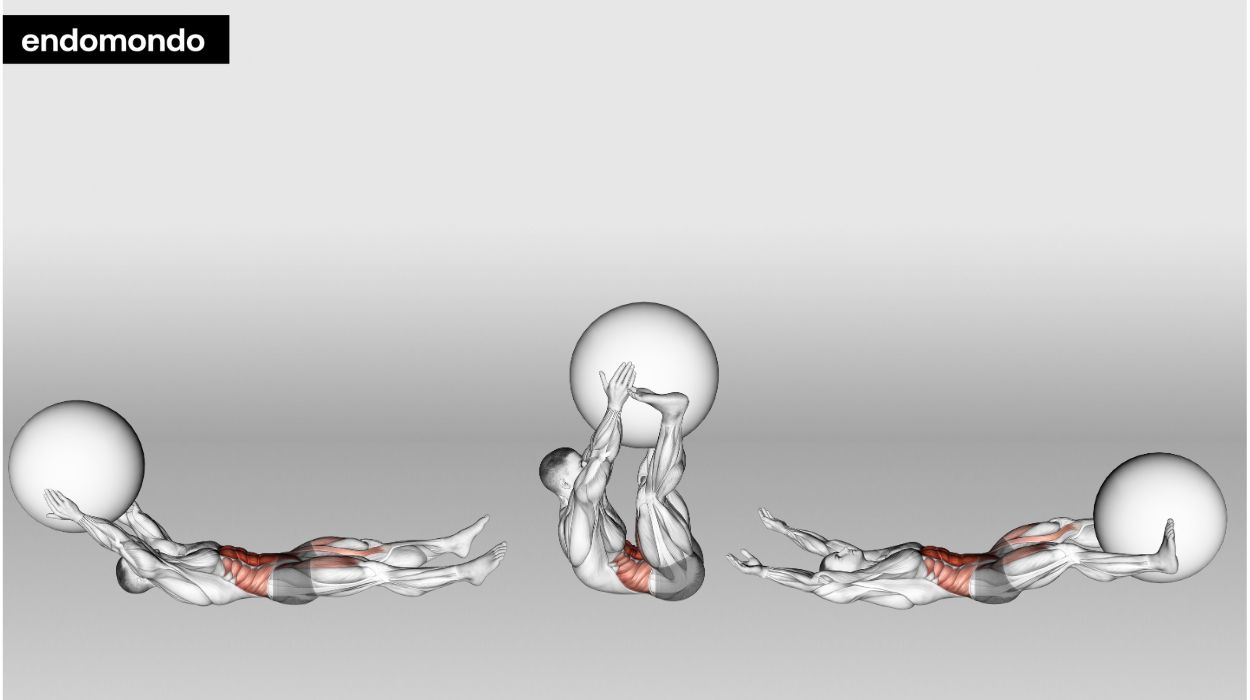
How to do:
- Lie face up with legs fully extended and arms straight overhead. Hold the ball between your hands.
- Engage your core as you crunch up and pass the ball between your hands and your feet.
- Keep your legs straight as you bring the ball down to the floor.
- Crunch up again to return the ball from your feet to your hands.
Tips:
- Keep your core engaged throughout the exercise to stabilize your spine and protect your lower back.
- Exhale as you reach your hands and feet toward each other, and inhale as you return to the starting position. Proper breathing helps maintain control and effectiveness.
- Avoid arching your lower back when reaching for the stability ball. Focus on using your core muscles to lift and control the movement, rather than relying on momentum.
Optimal Sets and Reps: 3 sets of 10-12 reps.
Stability Ball Bicycle Crunch
This stability ball exercise is an upper-ab workout and works the obliques. It is a simple exercise you can do anywhere.
How to do:
- Lie face up on the stability ball with your knees slightly bent and feet flat on the floor.
- Engage your core as you crunch up while raising your right knee toward your chest. Rotate your upper body to bring your left elbow to touch your right knee.
- Lower your foot and upper body at the same time.
- Switch sides and repeat.
Tips:
- Keep your lower back pressed into the floor and your core engaged throughout the exercise to protect your spine.
- Exhale as you bring your knee and elbow together, and inhale as you extend your leg and arm. This controlled breathing pattern helps maintain stability.
- Support your head with your hands, but avoid pulling on your neck. Focus on lifting your shoulder blades off the ground rather than tugging on your head, which can lead to neck discomfort.
Optimal Sets and Reps: 3 sets of 15-20 reps on each side.
Benefits Of A Strong Core
Back Pain Reduction
Everyday activities can cause chronic lower back pain if your spine isn’t strong and supported by your core. Strong muscles[1] in your core create support for your spine. This makes cleaning your home or car easier, washing dishes, mowing the lawn, vacuuming, and so much more.
If you experience chronic lower back pain from work, an old injury, improper form while exercising, or are simply sleeping wrong — strength training your core can help to reduce and sometimes prevent chronic lower back pain that would otherwise be debilitating.
Better Stability And Balance
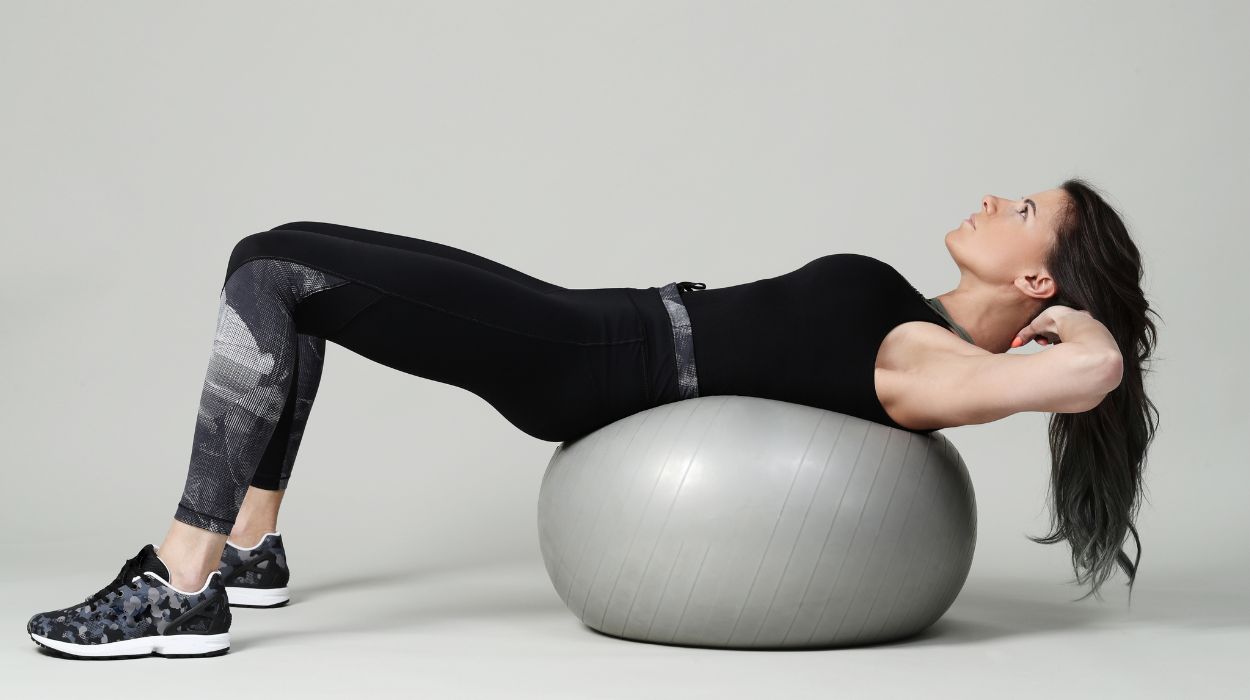
To walk, run, or get around every day, you need good stability and balance. Think about how often you walk downstairs, get dressed, or encounter slippery or icy surfaces.
By improving your core and ab strength, you increase sturdiness and security. This helps you to avoid slips and falls as you move around all day.
Preventing Injury
One of the best reasons to keep your abs and core strong[2] is to prevent injuries. The last thing you need is getting hurt while shoveling snow, taking out the trash, or reaching under the sink to grab something.
Maintaining strong abs helps you to avoid everyday injuries. This includes muscle or joint strains, fractured or bruised bones, and disk protrusions.
Mistakes To Avoid
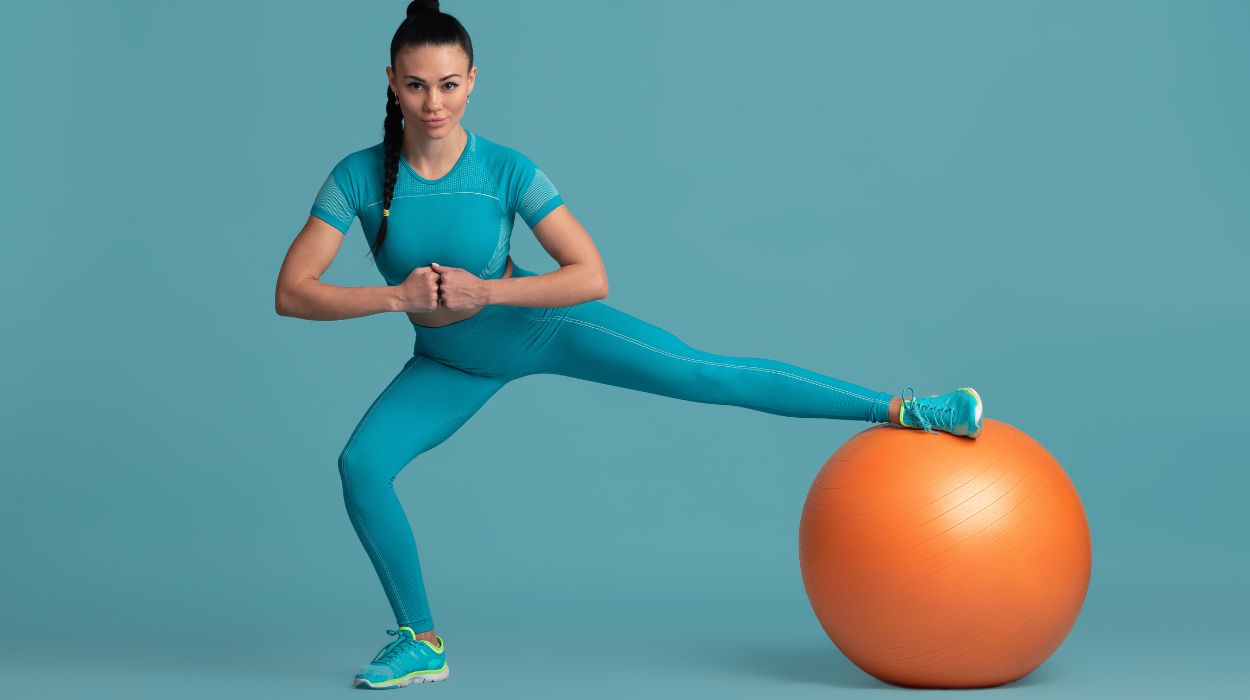
Don’t exercise with the wrong-sized ball. A Swiss ball, for example, comes in three sizes. If it’s too small or too big, it’ll cause you to use bad form, so be sure to try it out in person.
Using the wrong size stability balls can lead to injuries or ineffective workouts. Choose a ball based on your height and fill it with the proper amount of air because deflated balls, even at the right size, create problems.
Remember that a small amount of instability is normal and challenges your abs and core. But you shouldn’t be wobbling all over the place or toppling over after one rep. Widen your stance, place more of your body on the ball, or slow down.
When you’re moving incorrectly, you’re not targeting the muscles effectively. This creates a bigger risk of injury. Learn moves from a professional coach or trainer as they can show you which exercises tone your abs and core while helping correct bad form habits.
Conclusion
A stability ball is not just for sitting down. It’s also great for proper abs workouts. An ab ball workout targets and involves your body’s core, while lower ab workouts target oblique abdominal muscles.
Constantly doing sit-ups, repetitive crunches, or kettlebell ab workouts, get old fast. If your only option is following a monotonous abs routine to get those six-packs, you might not see it through. Wouldn’t getting rock-solid abs without doing sit-ups and crunches would be more fun?
Get your long-forgotten stability ball out of the closet and put it to good use. Ball ab exercises with proper form on an unstable surface build stronger muscles.
Do these ab workouts on a stability ball, with or without dumbbells, to get the abs you want and deserve.
Frequently Asked Questions
Exercise or medicine ball ab workouts strengthen your core, including your abdominal muscles. They also help build stronger back and pelvis muscles.
No, you should target your abs by working out every other day at most. This allows them enough time to recover. Track your workouts if you have difficulty telling whether you’re working them sufficiently.
Within one training session, you could do between two and five different ab workouts with exercise balls to see results.
Nearly everyone can train their abs[3] on a regular basis. However, if you are pregnant, then there are certain ab workouts you need to avoid.
Resources
- Thiago Montes Fidale, Farnesi, F., Roever, L., da, G., Alexandre Gonçalves, Eduardo Paul Chacur, Pimenta, C., Eduardo Gasparetto Haddad, Guilherme, Fábio Clemente Gregório, Cardoso, F., Franciel José Arantes, Santos, Adriano Alves Pereira, Karen, H., Guilherme Morais Puga and Frederico Balbino Lizardo (2018). Eletromyography of abdominal muscles in different physical exercises. Medicine, [online] 97(17), pp.e0395–e0395. doi:https://doi.org/10.1097/md.0000000000010395.
- Park, D.-J. and Park, S.-Y. (2019). Which trunk exercise most effectively activates abdominal muscles? A comparative study of plank and isometric bilateral leg raise exercises. Journal of Back and Musculoskeletal Rehabilitation, [online] 32(5), pp.797–802. doi:https://doi.org/10.3233/bmr-181122.
- Lee, J., Sang Woo Kim, Kim, D.-Y., Shim, J. and Lim, J. (2015). Effects of selective exercise for the deep abdominal muscles and lumbar stabilization exercise on the thickness of the transversus abdominis and postural maintenance. Journal of Physical Therapy Science, [online] 27(2), pp.367–370. doi:https://doi.org/10.1589/jpts.27.367.




